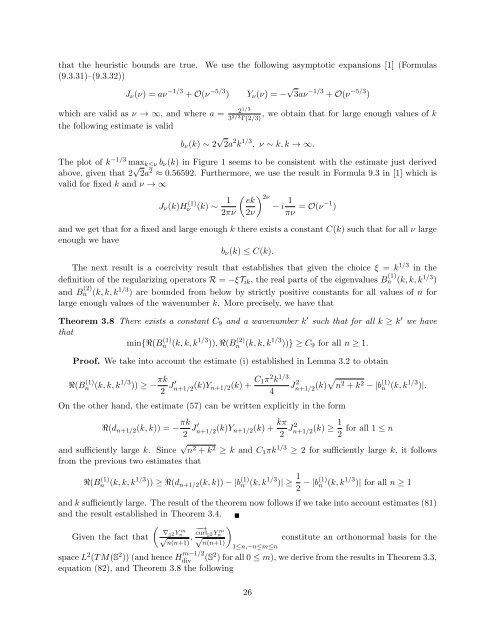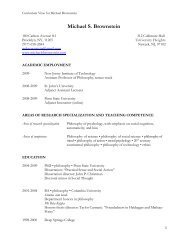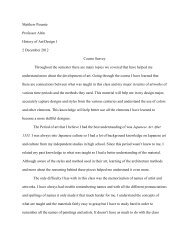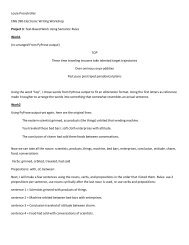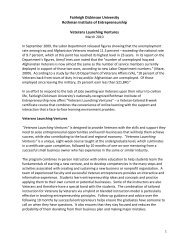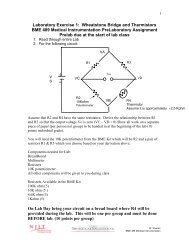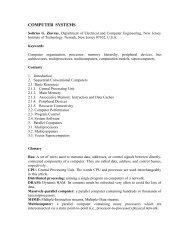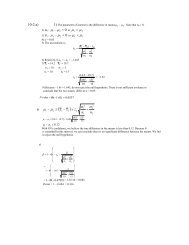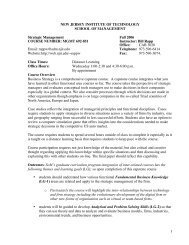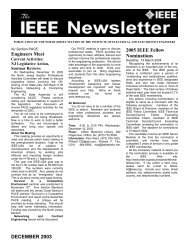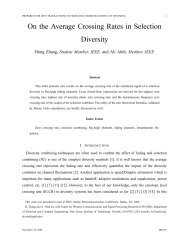Well-conditioned boundary integral formulations for the ... - Njit
Well-conditioned boundary integral formulations for the ... - Njit
Well-conditioned boundary integral formulations for the ... - Njit
You also want an ePaper? Increase the reach of your titles
YUMPU automatically turns print PDFs into web optimized ePapers that Google loves.
that <strong>the</strong> heuristic bounds are true.<br />
(9.3.31)–(9.3.32))<br />
We use <strong>the</strong> following asymptotic expansions [1] (Formulas<br />
J ν (ν) = aν −1/3 + O(ν −5/3 ) Y ν (ν) = − √ 3aν −1/3 + O(ν −5/3 )<br />
2<br />
which are valid as ν → ∞, and where a = 1/3<br />
<strong>the</strong> following estimate is valid<br />
3 2/3 Γ(2/3)<br />
b ν (k) ∼ 2 √ 2a 2 k 1/3 , ν ∼ k, k → ∞.<br />
, we obtain that <strong>for</strong> large enough values of k<br />
The plot of k −1/3 max k≤ν b ν (k) in Figure 1 seems to be consistent with <strong>the</strong> estimate just derived<br />
above, given that 2 √ 2a 2 ≈ 0.56592. Fur<strong>the</strong>rmore, we use <strong>the</strong> result in Formula 9.3 in [1] which is<br />
valid <strong>for</strong> fixed k and ν → ∞<br />
J ν (k)H (1)<br />
ν (k) ∼ 1<br />
2πν<br />
( ) ek 2ν<br />
− i 1<br />
2ν πν = O(ν−1 )<br />
and we get that <strong>for</strong> a fixed and large enough k <strong>the</strong>re exists a constant C(k) such that <strong>for</strong> all ν large<br />
enough we have<br />
b ν (k) ≤ C(k).<br />
The next result is a coercivity result that establishes that given <strong>the</strong> choice ξ = k 1/3 in <strong>the</strong><br />
definition of <strong>the</strong> regularizing operators R = −ξT ik , <strong>the</strong> real parts of <strong>the</strong> eigenvalues B n (1) (k, k, k 1/3 )<br />
and B n<br />
(2) (k, k, k 1/3 ) are bounded from below by strictly positive constants <strong>for</strong> all values of n <strong>for</strong><br />
large enough values of <strong>the</strong> wavenumber k. More precisely, we have that<br />
Theorem 3.8 There exists a constant C 9 and a wavenumber k ′ such that <strong>for</strong> all k ≥ k ′ we have<br />
that<br />
min{R(B n (1) (k, k, k 1/3 )), R(B n (2) (k, k, k 1/3 ))} ≥ C 9 <strong>for</strong> all n ≥ 1.<br />
Proof. We take into account <strong>the</strong> estimate (i) established in Lemma 3.2 to obtain<br />
R(B n<br />
(1) (k, k, k 1/3 )) ≥ − πk<br />
2 J n+1/2 ′ (k)Y n+1/2(k) + C 1π 2 k 1/3<br />
4<br />
On <strong>the</strong> o<strong>the</strong>r hand, <strong>the</strong> estimate (57) can be written explicitly in <strong>the</strong> <strong>for</strong>m<br />
R(d n+1/2 (k, k)) = − πk<br />
2 J ′ n+1/2 (k)Y n+1/2(k) + kπ 2 J 2 n+1/2 (k) ≥ 1 2<br />
J 2 n+1/2 (k)√ n 2 + k 2 − |b (1)<br />
n (k, k 1/3 )|.<br />
<strong>for</strong> all 1 ≤ n<br />
and sufficiently large k. Since √ n 2 + k 2 ≥ k and C 1 πk 1/3 ≥ 2 <strong>for</strong> sufficiently large k, it follows<br />
from <strong>the</strong> previous two estimates that<br />
R(B (1)<br />
n (k, k, k 1/3 )) ≥ R(d n+1/2 (k, k)) − |b (1)<br />
n (k, k 1/3 )| ≥ 1 2 − |b(1) n (k, k 1/3 )| <strong>for</strong> all n ≥ 1<br />
and k sufficiently large. The result of <strong>the</strong> <strong>the</strong>orem now follows if we take into account estimates (81)<br />
and <strong>the</strong> result established in Theorem 3.4. <br />
(<br />
∇<br />
Given <strong>the</strong> fact that S 2 Yn<br />
√ m −−→<br />
)<br />
curl<br />
, S 2 Yn<br />
√ m constitute an orthonormal basis <strong>for</strong> <strong>the</strong><br />
n(n+1) n(n+1)<br />
1≤n,−n≤m≤n<br />
space L 2 (T M(S 2 )) (and hence H m−1/2<br />
div<br />
(S 2 ) <strong>for</strong> all 0 ≤ m), we derive from <strong>the</strong> results in Theorem 3.3,<br />
equation (82), and Theorem 3.8 <strong>the</strong> following<br />
26


